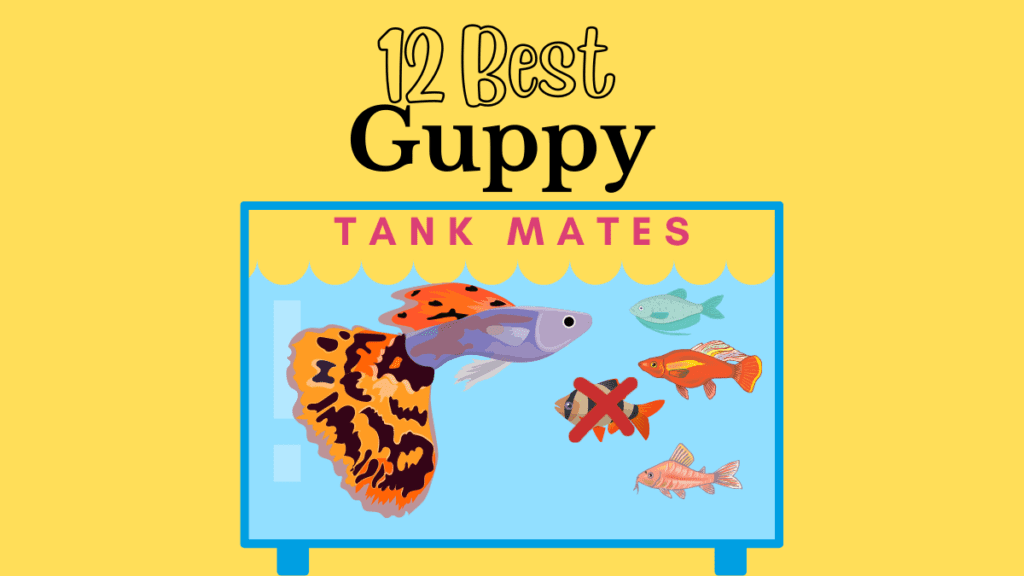Are you looking for tank mates for your Guppies? Guppies are very popular community fish. They are peaceful and lively fish that will get along with most community fish. Here are the 12 best tank mates for Guppies.
3 Factors to Consider When Selecting Guppies Tank Mates
When selecting tank mates for guppies there are 3 factors to consider to make sure your Guppies and tank mates are happy.
1. Guppies are not compatible with fin nippers
Never mix Guppies with aggressive fin nippers. Their beautiful fins will be a target for fin nippers like Tiger Barbs.
2. Big Fish are Bad Tank Mates for Guppies
Most fish will eat smaller fish that can fit in their mouth. Even the most peaceful fish are guilty of eating smaller fish. It’s their natural instinct! Definitely keep that in mind when choosing tank mates for Guppies. Avoid big fish, stick with small fish with small mouth as tank mates for Guppies.
3. Water Parameters Should be Similar to Guppies
When choosing tank mates for Guppies, make sure the water parameters are similar to what is required for Guppies. Guppies like medium, hard water that is slightly alkaline. Check the water parameter requirements of potential tank mates to make sure they are a good match with your Guppies.
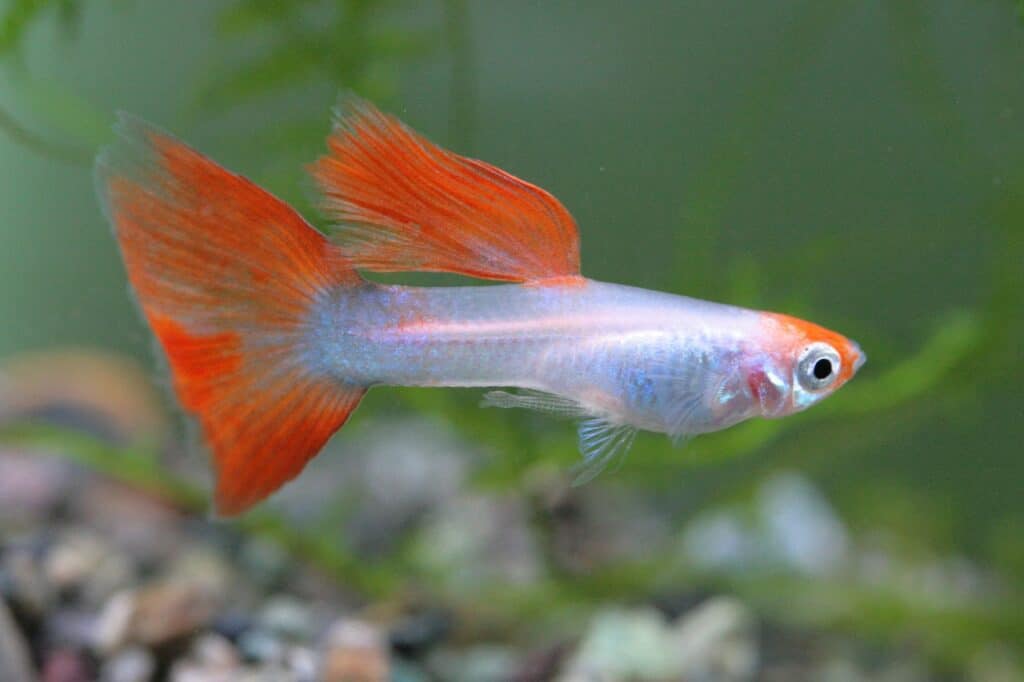
12 Tank Mates for Guppies
1. Platy (Xiphophorus maculatus)
Characteristics
| Name | Platy |
| Scientific Name | Xiphophorus maculatus |
| Origin | Central America Mexico, Guatemala, Honduras |
| Size | 2.5 inches (6 cm) |
| Temperament | Peaceful |
| Ease of Care | Easy |
| Water Parameters | Medium Hard to Alkaline, pH 7.5 |
| Water Temperature | 64-77F (18-25C) |
| Water Column | Midwater Fish |
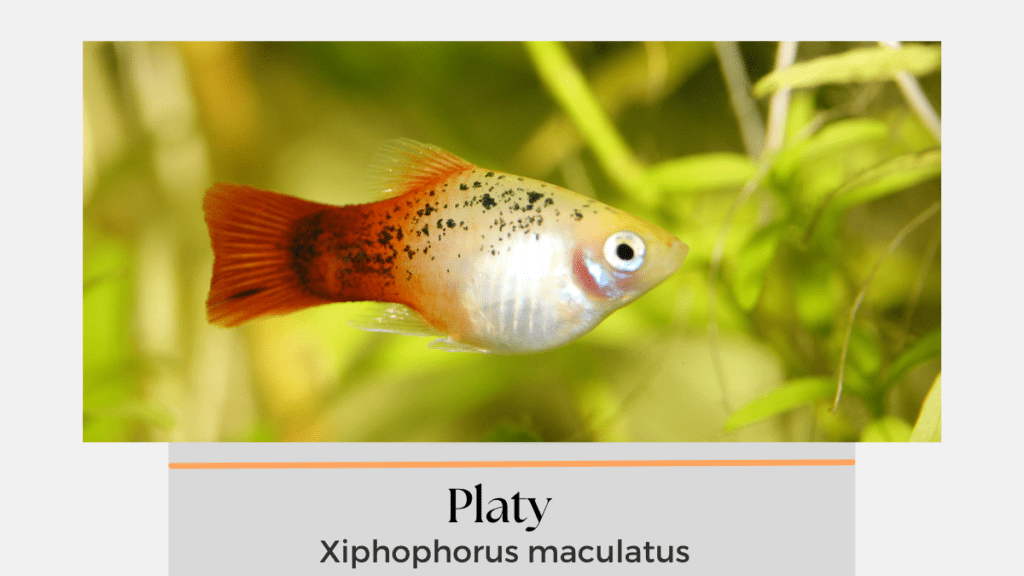
Platies are a top choice when it comes to choosing tank mates for Guppies. Platies are popular community fish. They are peaceful and hardy fish that are great for beginners.
Platies come in many color varieties from albino to vibrant orange. The combination of platies and guppies will look amazing in any community tank.
Similar to Guppies, Platies are also livebearers. They breed easily so its a great fish for anyone new to fish breeding. Both Platies and Guppies will eat fry. Provide plenty of rocks and plants for fry to hide in. Otherwise, separate the female in a breeding box to increase the chances of fry survival.
Female Platies will give birth to 50 fry every 4-6 weeks and large female Guppies can give birth to 100 fry! Keep that in mind when selecting tank size for your guppies and platies. My advice is to choose the biggest tank that works within your budget and your space.
2. Swordtail (Xiphophorus helleri)
Characteristics
| Name | Swordtail |
| Scientific Name | Xiphophorus helleri |
| Origin | Central America Mexico, Guatemala, Honduras |
| Size | 4 inches (10 cm) |
| Temperament | Peaceful |
| Ease of Care | Easy |
| Water Parameters | Medium Hard to Alkaline, pH 7.5 |
| Water Temperature | 70-77F (21-25C) |
| Water Column | Midwater Fish |
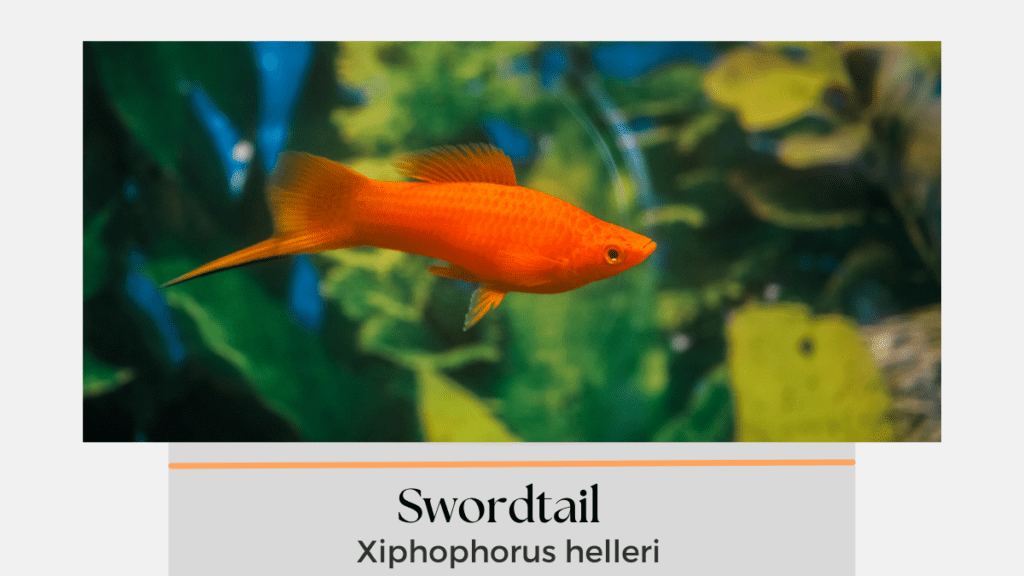
Swordtails are another top choice when it comes to choosing tank mates for your Guppies. Swordtails are popular community fish. They are active and peaceful. Male Swordtails are characterized by the sword-like tail. There are many color variations of swordtails but the most popular are the orange colored swordtails.
Swordtails will do well in the same tank as Guppies because Guppies tend to stay in the top to mid level of the water column while Swordtails are usually in the mid level area of the water column. In addition, Guppies and Swordtails have similar water parameter requirements with a preference for medium hard to alkaline water with temperature of 70-77F (21-25C).
Like Guppies, Swordtails are also live bearers. They breed easily. Mature female swordtails can give birth to 200 fry! Just know that both Guppies and Swordtails will eat fry. Separate the female in a breeding box to increase the chances of fry survival. Provide plenty of rocks and plants for the fry to hide in.
Although Swordtails are generally peaceful, know that male Swordtails can get aggressive towards each other so its best to either keep male Swordtails in a group or as a single male in your tank. If you keep 2 male Swordtails, there is a high chance that one of the male Swordtails will be bullied.
3. Black Molly (Poecilia sphenops)
Characteristics
| Name | Black Molly |
| Scientific Name | Poecilia sphenops |
| Origin | Central America Mexico, Guatemala, Honduras |
| Size | 3.5 inches (8.5 cm) |
| Temperament | Peaceful |
| Ease of Care | Easy |
| Water Parameters | Brackish Water. Hard Water. Alkaline, pH 7.5 |
| Water Temperature | 75-81F (24-27C) |
| Water Column | Midwater Fish |
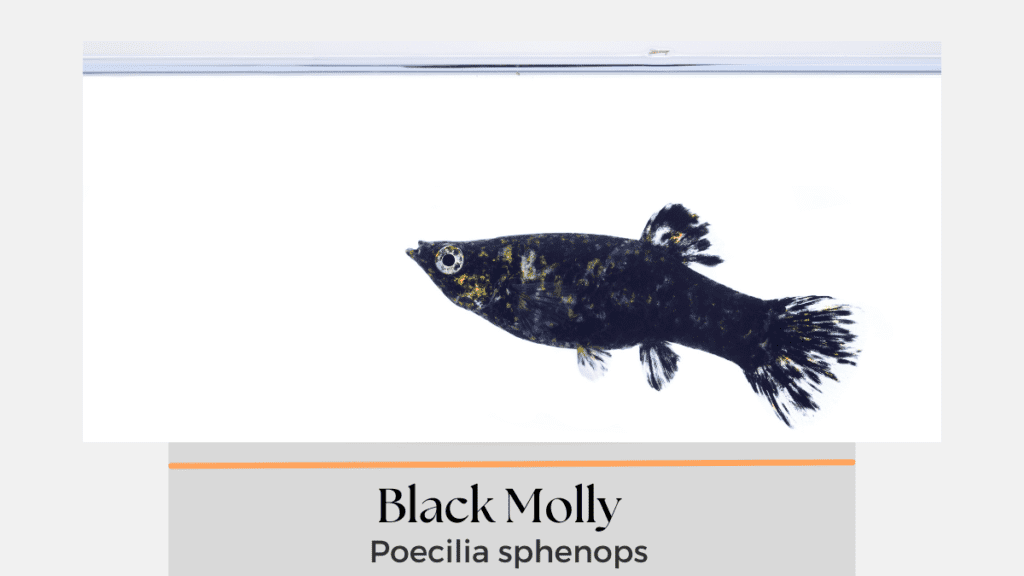
Black Mollies are good tank mates for Guppies. Both Guppies and Mollies are peaceful fish and will get along well in the same aquarium. Keep them in a well-planted tank with open swim areas.
The combination of all black against the silver and multi-colored tails of guppies will look great in your aquarium. Although there are other color varieties of Poecilia sphenops, by far the most well known and most widely distributed are the Black Mollies.
Similar to Guppies, Black Mollies are also livebearers. Female Black Mollies give birth to a few dozen fry. Both Guppies and Black Mollies will eat fry. Black Mollies have big mouths and can easily eat fry. You should separate the female in a breeding box to increase the chances of fry survival. Provide plenty of rocks and plants for fry to hide in.
From personal experience Black Molly fry are big and somehow adult Guppies have a harder time eating them. Although, I’ve once seen an adult guppy swimming around with a black tail sticking out of its mouth! It’s the opposite for Guppy fry, they are definitely snack food for adult Black Mollies.
One important thing to know about Black Mollies is they are susceptible to diseases if the water is not slightly brackish or hard. Guppies will thrive in the same water parameters as Black Mollies.
4. Bronze Corydoras (Corydoras aeneus)
Characteristics
| Name | Bronze Corydoras or Cory Cats |
| Scientific Name | Corydoras aeneus |
| Origin | South America |
| Size | 2.75 inches (7cm) |
| Temperament | Peaceful |
| Ease of Care | Moderate |
| Water Parameters | Soft, pH 6-7 |
| Water Temperature | 64-79F(18-26C). |
| Water Column | Bottom Dweller Fish |
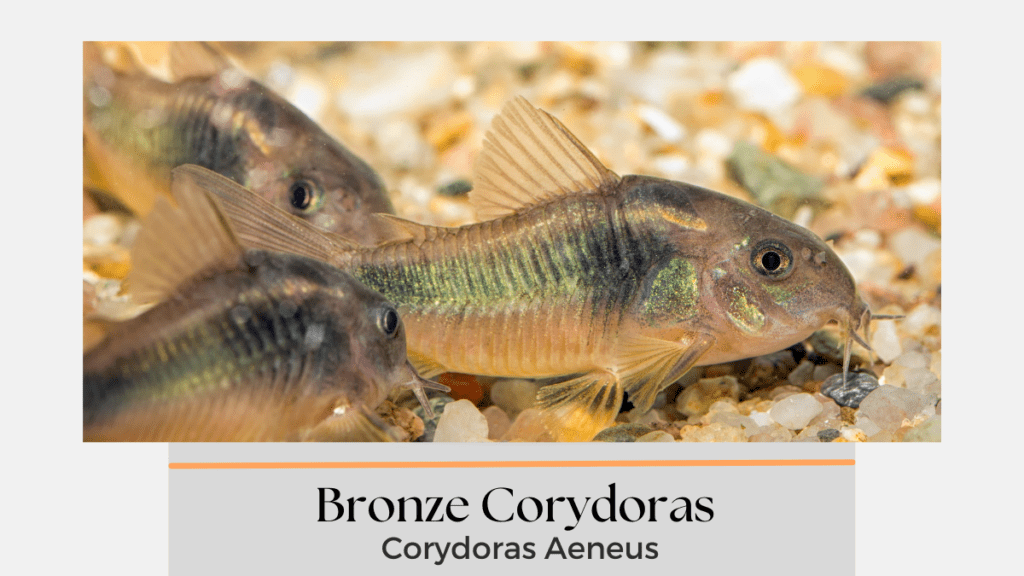
Bronze Corydoras or Bronze Corys are compatible with Guppies. Both will get along nicely since Bronze Corydoras will stay near the substrate while Guppies are usually swimming in the mid to upper level of the water column. In fact, Bronze Corydoras will help keep the tank clean and will eat any uneaten food that falls during feeding!
There are many color variations of Corydoras aeneus. Bronze Corydoras is the most widely distributed Corydoras aeneus. The Albino Corydoras is also another color variation of Corydoras aeneus and will be good tank mates with Guppies.
Bronze Corydoras are hardy fish and can tolerate a wide range of water parameters which makes them easy, adaptable fish. Bronze Corydoras are social and should be kept as a group. If you have space in your aquarium, keep at least 5 Corydoras in a group.
Even though Bronze Corydoras feed on uneaten food. You should still feed Bronze Corydoras their own food. It’s not enough to rely on food collected from scavenging as their only food source. Supplement their diet with sinking pellets that are formulated for bottom-dwelling fish.
Bronze Corydoras will thrive in a well planted aquarium with open swim areas. Bronze Corydoras spend their day digging and will use their mouth to dig the substrate. Use fine substrate like sand instead of gravel in your aquarium to make it easier for Cory Cats to dig and to prevent damaging their whisker-like barbels.
5. Cardinal Tetra (Paracheirodon axelrodi)
Characteristics
| Name | Cardinal Tetra |
| Scientific Name | Paracheirodon axelrodi |
| Origin | South America |
| Size | 2 inches (5 cm) |
| Temperament | Peaceful, Social schooling fish |
| Ease of Care | Moderate |
| Water Parameters | Soft and acidic, pH 5.8 |
| Water Temperature | 75-82F (24-28C) |
| Water Column | Midwater Fish |
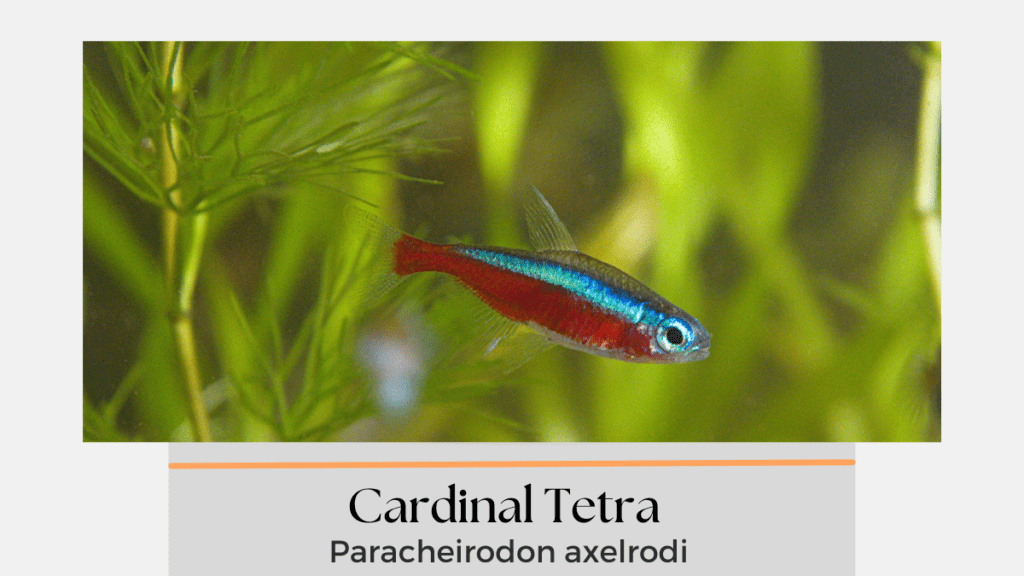
Cardinal Tetras and Guppies can live together in the same tank. They are peaceful and will get along nicely with each other. Cardinal Tetras are a schooling fish and should be kept in a group of at least 6 in your fish tank. They are active schooling fish. The bold red and blue coloring will look striking in your Guppy aquarium.
Keep Cardinal Tetras and Guppies in a well-planted tank with plenty of open space for swimming. In the wild, Cardinal Tetras live in streams so they will appreciate a gentle current. Use an internal canister filter in the tank. Cardinal Tetras don’t like bright lights, too much light will cause them to retreat and will result in pale coloration. Use plants to filter the light.
When setting up your Cardinal Tetra and Guppy tank, you need to keep in mind that Cardinal Tetras are sensitive to poor water conditions. They don’t do well in new tanks. They prefer soft, slightly acidic water. If you can, set up a well established tank first before introducing Cardinal Tetras. I suggest introducing the Guppies first and let the tank cycle and establish itself. Wait a week or two before introducing Cardinal Tetras to your Guppy tank.
Your guppies will be prolific breeders but don’t expect your Cardinal Tetras to breed easily. The chances are low that they will breed in your home aquarium.
Feed Cardinal Tetras and guppies tropical flakes. Crush the flakes with your fingers so its small enough for them to comfortably eat.
6. Glowlight Tetra (Hemigrammus erythrozonus)
Characteristics
| Name | Glowlight Tetra |
| Scientific Name | Hemigrammus erythrozonus |
| Origin | South America |
| Size | 1.5 inches (4 cm) |
| Temperament | Peaceful, Social schooling fish |
| Ease of Care | Moderate |
| Water Parameters | Soft and acidic, pH 6 |
| Water Temperature | 73-82F (23-28C) |
| Water Column | Midwater Fish |
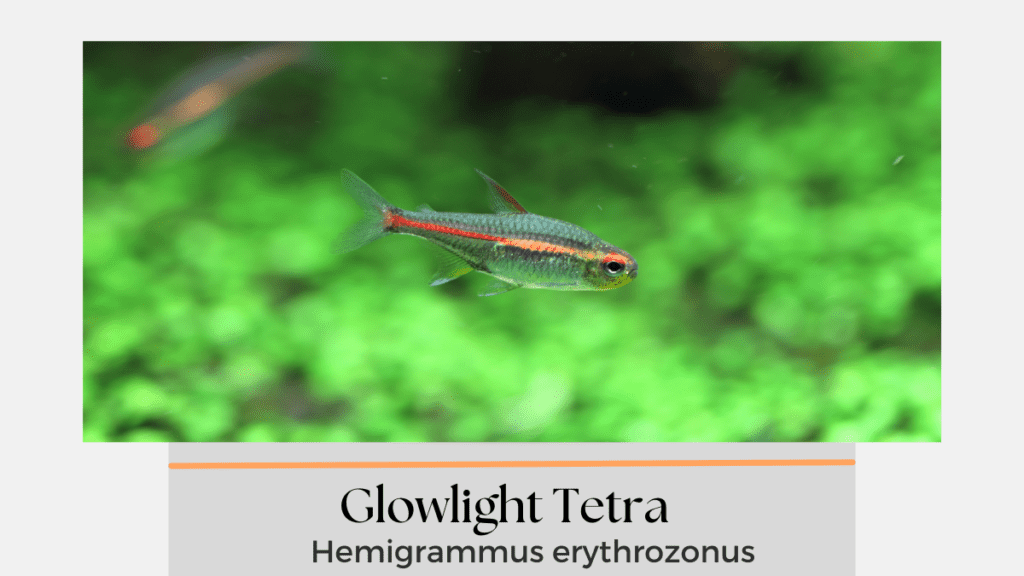
Glowlight Tetras and Guppies can live together in the same aquarium. Both Guppies and Glowlight Tetras are peaceful and social so they will make good tank mates. Glowlight Tetras as schooling fish so you should get at least 6 Glowlight Tetras in your Guppy aquarium. Glowlight Tetras are characterized by the red/gold stripe on its body. A school of Glowlight Tetras with Guppies will look amazing in your tank.
Glowlight Tetras are great tetras for beginners. They are hardy fish and easy to care for.
Similar to Cardinal Tetras, Glowlight Tetras will not breed easily in your aquarium. Your guppies will be prolific breeders though. Provide plenty of plants and rocks for your guppy fry to hide in.
Feed Glowlight Tetras and guppies tropical flakes. Crush the flakes with your fingers so its small enough for them to comfortably eat. The colors of Glowlight Tetras can be enhanced with good nutrition and diet.
7. Neon Tetra (Paracheirodon innesi)
Characteristics
| Name | Neon Tetra |
| Scientific Name | Paracheirodon innesi |
| Origin | South America |
| Size | 1.25 inches (3 cm) |
| Temperament | Peaceful, Social schooling fish |
| Ease of Care | Moderate |
| Water Parameters | Soft and acidic, pH 5.8 |
| Water Temperature | 75-82F (24-28C) |
| Water Column | Midwater Fish |

Neon Tetras are the most famous of all tetras. Neon Tetras are good tank mates with Guppies. Both fish are peaceful and social fish and will get along well with each other. Keep at least a group of 6 Neon Tetras in your aquarium.
The bold red and blue coloring of a school of Neon Tetras will look amazing with the colorful guppy tails. Neon Tetras are often confused with the Cardinal Tetras. The red stripe of Cardinal tetras extends from the front to the back of the body while the red stripe of Neon tetras are isolated to the back half of the body.
Unlike guppies, Neon Tetras are difficult to breed at home. Do make sure you have a well-planted tank with some swim area and lots of hiding spots for your guppy fry.
Neon Tetras prefer soft, slightly acidic water but can tolerate harder more alkaline water. Use an internal canister filter in the tank. Neon Tetras don’t like bright lights. You can use floating plants to filter bright light.
Feed Neon Tetras tropical flakes. Crush the flakes with your fingers so its small enough for them to comfortably eat.
8. Otocinclus (Otocinclus affinis)
Characteristics
| Name | Otocinclus or Otos |
| Scientific Name | Otocinclus affinis |
| Origin | South America |
| Size | 1.5 inches (4 cm) |
| Temperament | Peaceful |
| Ease of Care | Moderate |
| Water Parameters | Soft and Slightly Acidic, pH 6.5-7.0 |
| Water Temperature | 72-77F (22-25C) |
| Water Column | Bottom Dweller |
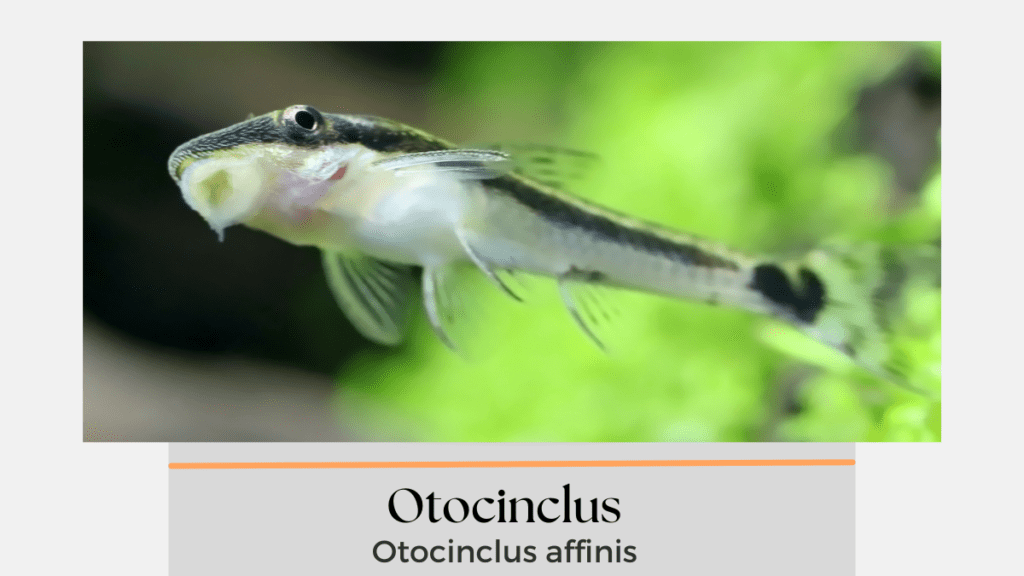
Otocinclus or Otos are peaceful fish that will not bother your Guppy. Otocinclus will make good tank mates with your Guppies. They are algae eaters and will cleanup the algae in the aquarium and on plants. They are a great addition to your Guppy tank. Get a group of Otos so they have company, since they are not solitary fish.
Otocinclus are sensitive to nitrate levels so it’s important to keep water quality in good condition with water changes.
Otocinclus are egg layers. The female will lay eggs on plant leaves. The eggs will hatch in 3 days. Feed fry special fry food or live brine shrimp.
9. Bristlenose Catfish (Ancistrus temminckii)
Characteristics
| Name | Bristlenose Catfish or Bristlenose Pleco |
| Scientific Name | Ancistrus temminckii |
| Origin | South America |
| Size | 6 inches (15cm) |
| Temperament | Territorial |
| Ease of Care | Moderate |
| Water Parameters | Soft to Acidic, pH 6-7 |
| Water Temperature | 75-82F (24-28C) |
| Water Column | Bottom Dweller Fish |
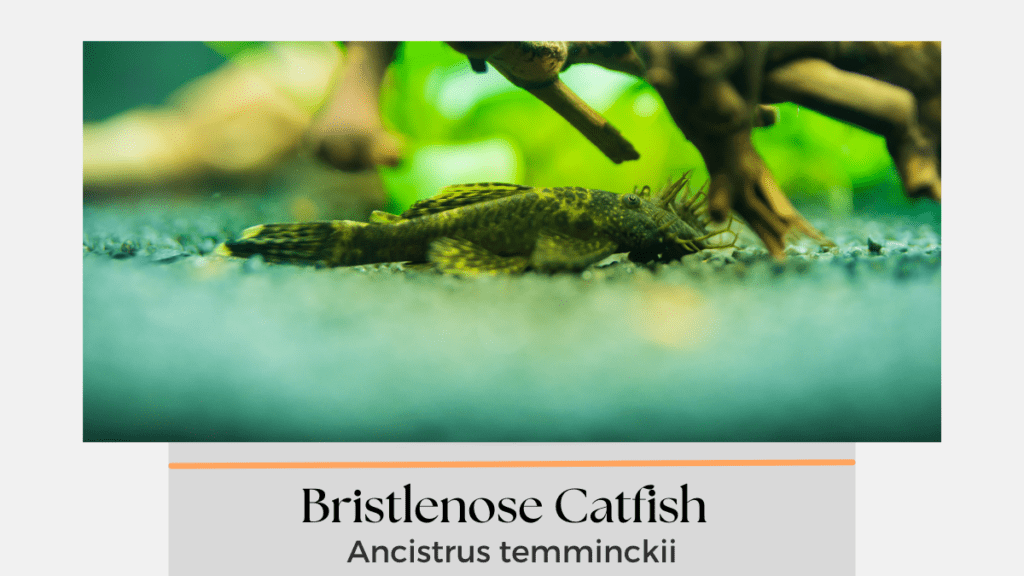
Bristlenose Catfish or Bristlenose Pleco is a good tank mate for your Guppies. It’s a bottom dweller, algae eater that will get out of the way of your Guppies. Your Guppies will occupy the upper to mid water column of the aquarium while Bristlenose Pleco will stay at the bottom. Bristlenose Catfish can get territorial with other Bristlenose Catfish and other bottom dwellers so it’s best to keep just one or a pair of Bristlenose Catfish (one male and one female).
Bristlenose Catfish are good algae eaters and will do a good job cleaning your tank. Make sure you supplement their feeding with sinking pellets because they will feed on aquarium plants if there is not enough algae in the aquarium.
Bristlenose Plecos are egg layers. The female will lay eggs on roots. The male Bristlenose Catfish will take care of the eggs and fry. Eggs will hatch in 5 days.
10. Honey Gourami (Colisa chuna)
Characteristics
| Name | Honey Gourami |
| Scientific Name | Colisa chuna |
| Origin | Asia |
| Size | 2 inches (5 cm) |
| Temperament | Peaceful but will become territorial when Breeding |
| Ease of Care | Moderate |
| Water Parameters | Soft to Neutral, pH 6-7 |
| Water Temperature | 75-82F (24-28C) |
| Water Column | Midwater Fish |
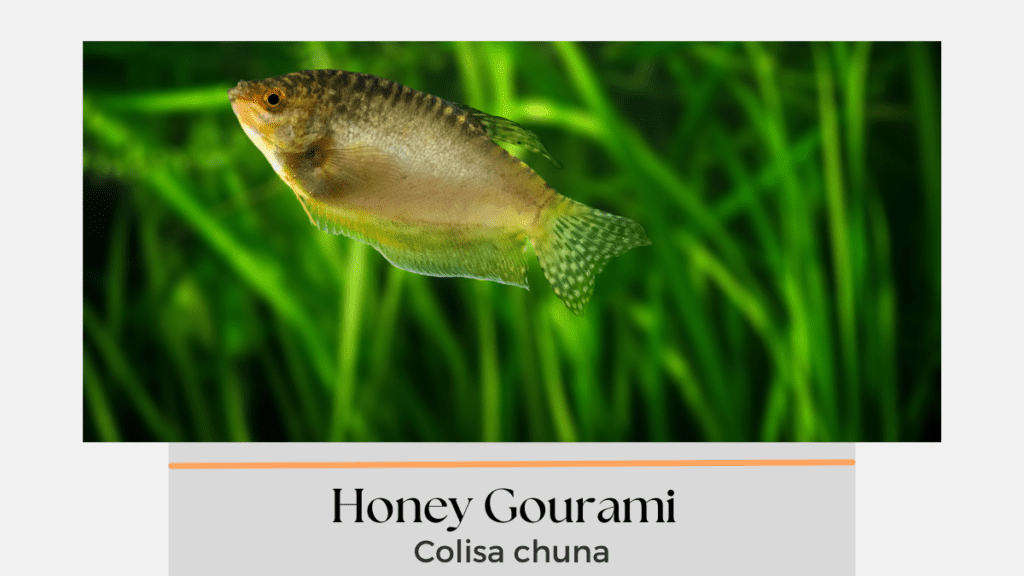
Honey Gouramis are beautiful centerpiece fish for community tanks. Both Honey Gouramis and Guppies will live peacefully with each other. They also overlap in terms of water parameters so they can live together in the same tank.
Compared to other Gouramis, Honey Gouramis are generally more peaceful. Its best to keep only one Honey Gourami per tank since there still could be some aggression between Gouramis. If you do decide to keep more than one Gouramis, I suggest keeping one male and the rest females.
Honey Gouramis will also get territorial when spawning. They should be kept in a separate tank when breeding. Honey Gouramis are prone to Velvet Disease. Keep Honey Gouramis and Guppies in a well planted tank with gentle filtration. Honey Gouramis will eat baby Guppies so you should have plenty of hiding space for the Guppy fry. Otherwise, have a breeding box and separate the female Guppy when she is about to give birth.
11. Red Cherry Shrimp (Neocaridina davidi)
Characteristics
| Name | Red Cherry Shrimp |
| Scientific Name | Neocaridina davidi |
| Origin | Asia (Taiwan) |
| Size | 1.5 inches (4 cm) |
| Temperament | Peaceful |
| Ease of Care | Moderate |
| Water Parameters | Slightly acidic to Neutral, pH 6.6-7.0 |
| Water Temperature | 72-82F (22-26C) |
| Water Column | Bottom Dweller |
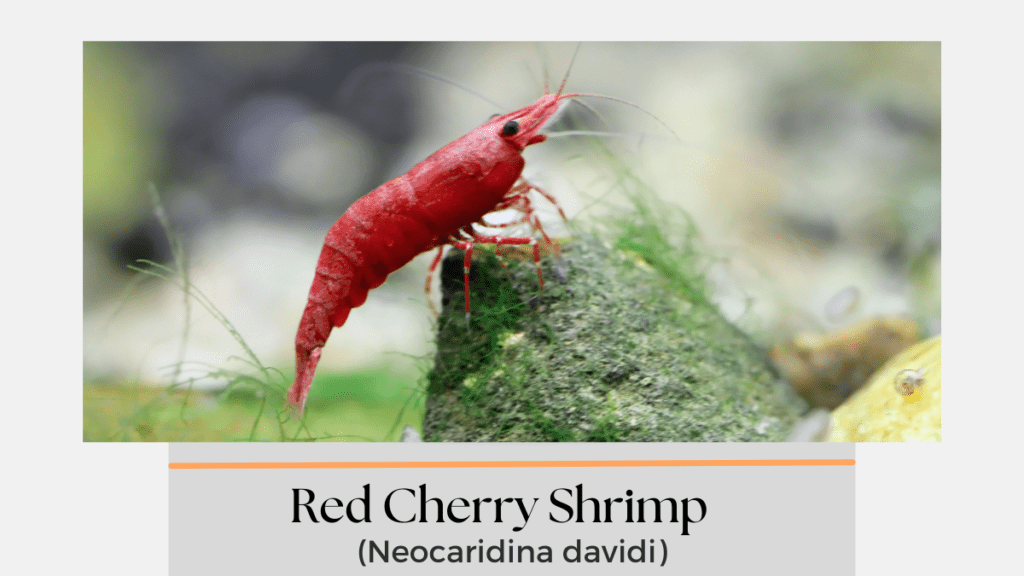
Red Cherry Shrimp or Cherry Shrimp will make great tank mates with your Guppies. Cherry Shrimp will stay out of the way and will not bother your Guppies.
Red Cherry Shrimp are a great choice if you are looking for something different as a bottom dweller in your aquarium. They are unique and fun to keep as pets in your aquarium. They are also easy to breed similar to your Guppies.
Red Cherry Shrimp are tank cleaners. They will continually graze and feed on algae, uneaten food and decaying vegetation.
12. Ember Tetra (Hyphessobrycon amandae)
Characteristics
| Name | Ember Tetra |
| Scientific Name | Hyphessobrycon amandae |
| Origin | South America |
| Size | 1.25 inches (3 cm) |
| Temperament | Peaceful |
| Ease of Care | Moderate |
| Water Parameters | Soft and neutral, pH 7.0-7.5 |
| Water Temperature | 68-82F (20-28C) |
| Water Column | Midwater Fish |
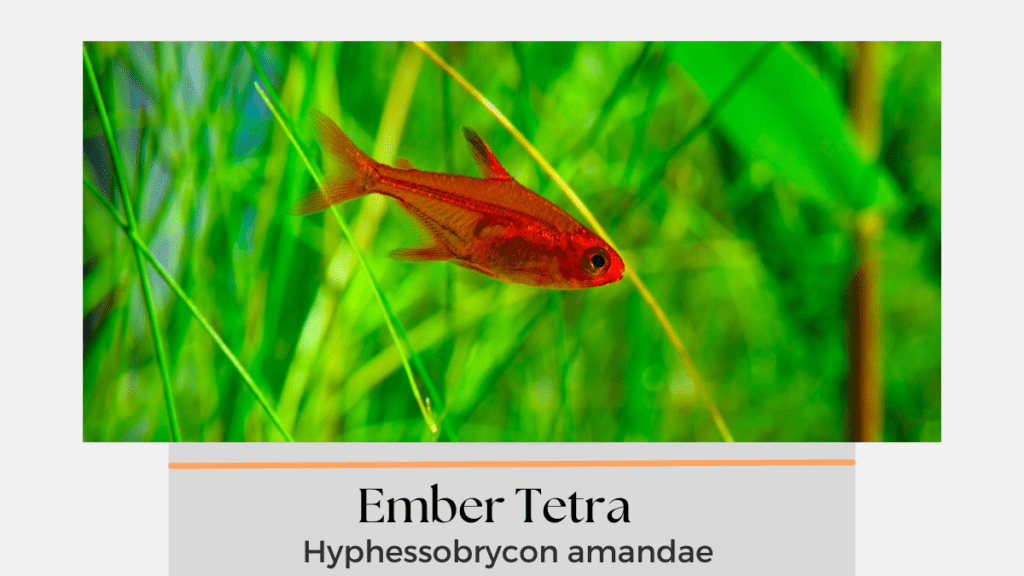
Ember Tetras and Guppies can live together in the same tank. They are peaceful and social. Keep at least 6 Ember Tetras in your aquarium. A school of Ember Tetras with the bold orange and red colors will look amazing in your Guppy aquarium. Provide caves and rocks for hiding since they do have some nervous tendencies.
Unlike Guppies, Ember Tetras are difficult to breed. Do expect lots of fry though from your Guppies. Guppies are prolific breeders! Set up a well-planted tank with plenty of hiding spots for the Guppy fry.
Feed Ember Tetras tropical flakes. Crush the flakes with your fingers so its small enough for them to comfortably eat.
Can You Keep Danios with Guppies?
Yes, you can keep Danios with Guppies in the same aquarium. Their water parameter requirements are similar so that should not be a problem. Although, Danios prefer cooler water, you can keep the tank on the cooler side. When keeping both Danios and Guppies together, you should make sure you have a tank that fosters peaceful cohabitation. Below are two things you need to do to ensure Danios and Guppies can live peacefully in the same tank.
1.Make sure the tank is large enough
You need to make sure there is enough space in the tank. Have at least a 20 gallon tank.
2. Make sure you keep a large enough group of Danios and Guppies.
You should keep at least 6 Danios in your tank. Keeping a big group of Danios will ensure there is no aggression towards Guppies. After all, you don’t want Danios to nip the fins of your Guppies! Guppies should also be in a group, keep at least 4 Guppies in your tank.
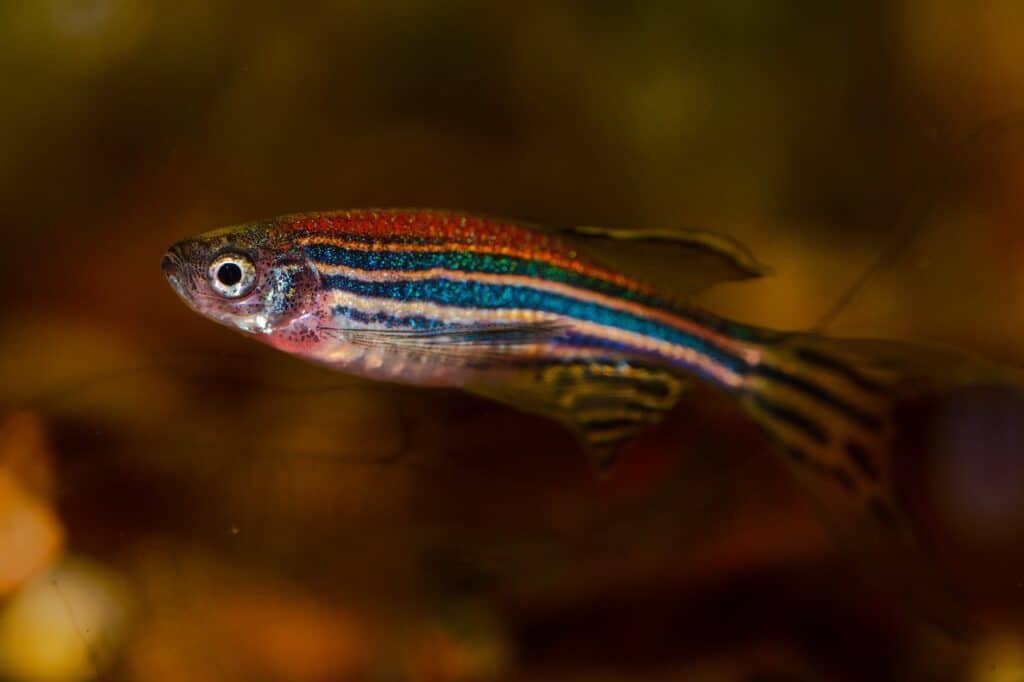
Can You Keep Guppies with Bettas?
It’s not advisable to keep Guppies with Betta. The reason for this is that Guppies have long colorful tails making Guppies a target of Betta aggression. Especially if you have a male Betta and a male Guppy in the same tank, for sure your Betta will pick on your Guppy. Your Guppy will not stand a chance against a Betta. Male Bettas fight to the death with other Male Bettas. You don’t want the same fate for your Guppy!
Some fishkeepers have tried female Bettas with female Guppies since female Guppies are more drab and not as colorful. However, I still don’t advise it because Bettas have a natural instinctive aggression. Female Bettas can be aggressive to each other when establishing the pecking order for the group. You don’t want your female Guppies to be the subject of that aggression!
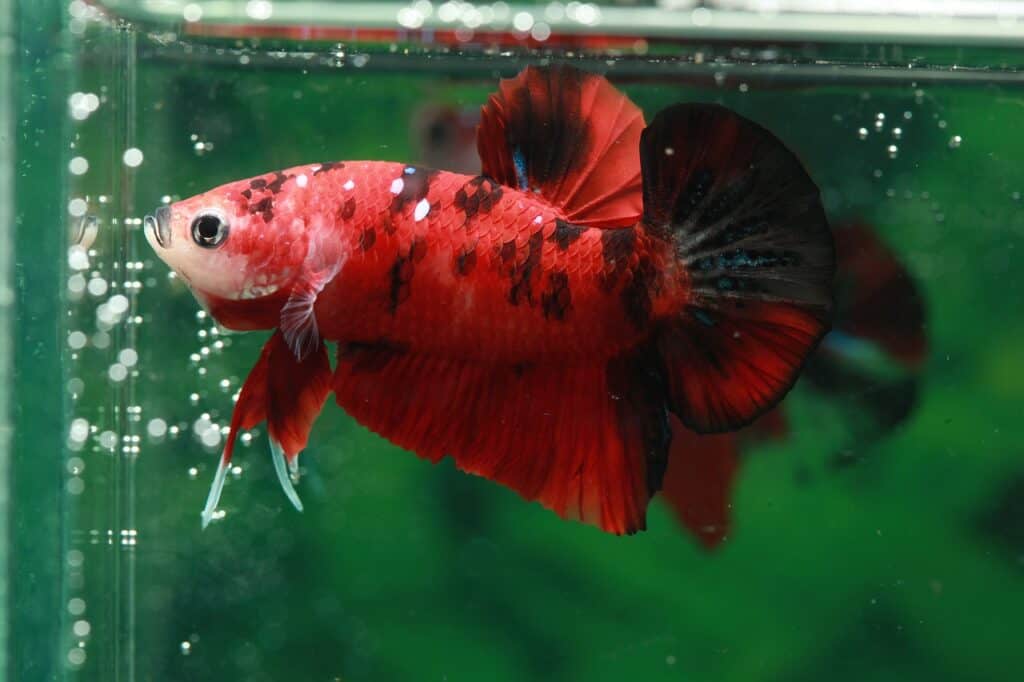
Can You keep Guppies with Goldfish?
I don’t recommend keeping Guppies with Goldfish. There are 2 main reasons why I don’t think Guppies should be tank mates with Goldfish. The first reason is that Goldfish is a coldwater fish preferring 50-70F (they don’t even need a heater). Guppies on the other hand will need a heater to maintain warmer water of 70-77F.
The second reason why I don’t think Guppies should live in the same tank as Goldfish is that your Goldfish will eat Guppies. Goldfish can grow large (up to 12 inches!) and they will eat anything that fits in their mouth. Guppies are prolific breeders so for sure your Goldfish will eat up all the Guppy fry. In addition, Guppies are small so there is a chance your Goldfish will eat adult Guppies. Play it safe, you don’t want to see a Guppy tail sticking out of your Goldfish mouth! Because of these two reasons, I don’t think its a good idea to keep Guppies and Goldfish in the same aquarium.
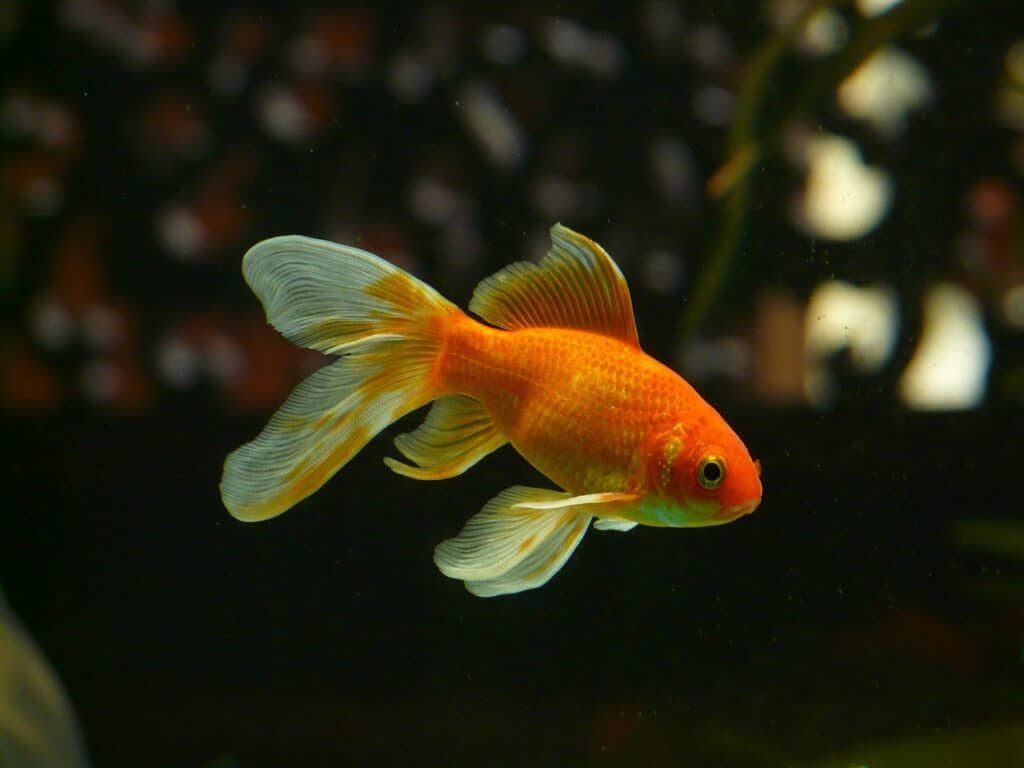
Can You Keep Guppies with Rainbowfish?
Guppies can live with Rainbowfish in the same tank but they are not my first choice tank mates. Rainbowfish can grow rather large compared to Guppies. For example, Boeseman’s Rainbowfish can grow to 4.75 inches while Guppies can grow to 2 inches but are usually 1.5 inches. That is a big size difference. Anytime you have a big discrepancy is size of fish in the same tank it can become problematic. Rainbowfish are bigger, faster, schooling fish and that can be intimidating for your Guppies. Some have tried putting both Rainbowfish and Guppies together in the same tank with success but I would be cautious and observe your fish to make sure they are living peacefully with each other. It also helps if you have a big tank. If you are planning to put Rainbowfish and Guppies in a 20 gallon tank, I don’t recommend it. However, if you are planning to put Rainbowfish and Guppies in a 50 gallon or larger tank, then that will be okay since they will have more space to carve out their territories.
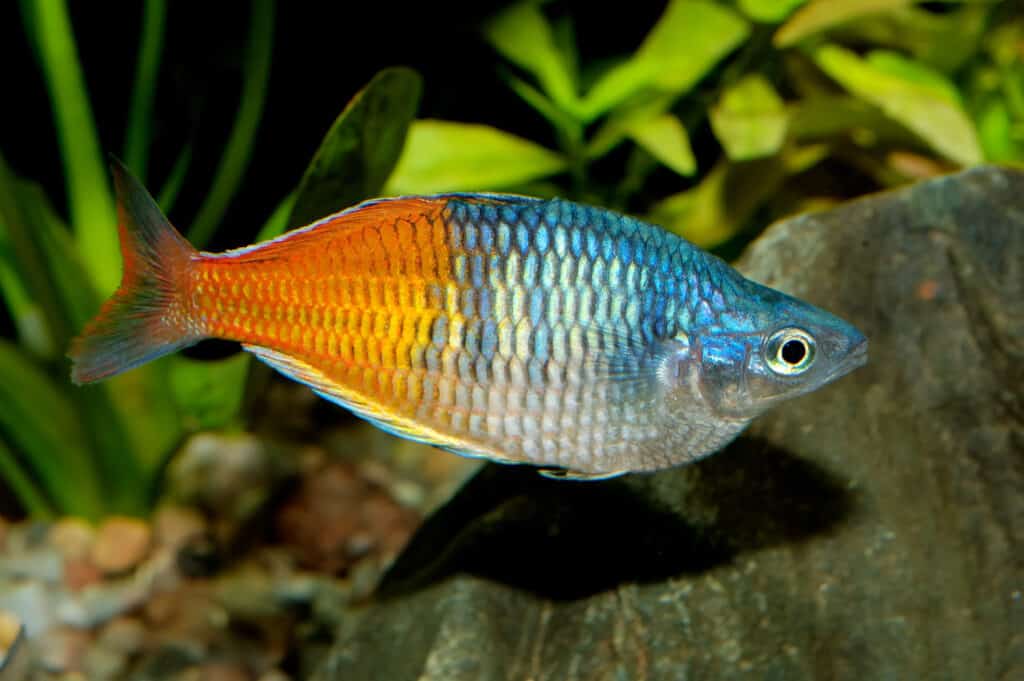
How to Set Up a Community Tank for Guppies
To set up a Guppies community tank, get the largest tank possible (within your budget and space). Add plants, rocks and aquarium decorations. This will ensure you have enough hiding space for Guppy fry. Your substrate can be gravel or sand but if you have Corydoras and Plecos as tank mates then it’s best to go with sand as your substrate. The fine substrate will their mouth and barbels. Keep a well-filtered tank with either a hang-on filter or internal filter canister. You will also need a heater to regulate the temperature.
Below is a list of equipment you need to set up your Guppies community tank:
- Filter: Internal Canister Filter or Hang on Filter
- Heater: Tank Heater
- Aquarium Decor: Caves or Plastic Plants or Sponge Bob House
- Live Plants: Java Fern or Anubias Nana
- Substrate: Coloful Gravel or Sand
- Maintenance: Gravel cleaner, Bucket, Water Conditioner and Glass Cleaner
Guppy (Poecilia reticulata)
Characteristics
| Name | Guppy |
| Scientific Name | Poecilia reticulata |
| Origin | Central America Mexico, Guatemala, Honduras |
| Size | 2 inches (5 cm) |
| Temperament | Peaceful |
| Ease of Care | Easy |
| Water Parameters | Medium Hard Water. Alkaline, pH 7.5 |
| Water Temperature | 70-77F (21-25C) |
| Water Column | Midwater Fish |
You May Also Be Interested In: Best Fish for Beginners

